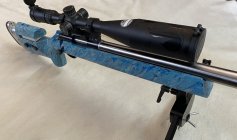There are three possible ways that TR may be hamstrung relative to Open, but which of them is actually true, and/or by a material amount, when we shoot for score, not group?
1) the cartridges cannot compete in the wind;
2) shooting off a bipod is inferior to shooting off an Open rest,
3) a heavier TR rifle could shoot better than a rule-compliant one.
So, why the curiosity, because TR leaders at 600 and 1,000 are really closing in on F-Open scores, despite the limitations. We in open push our barrels more for life into flyers, deal with heat induced vertical, and haven’t had quite the bullet revolution that TR has over this generation.
The two TR cartridges are tagged as if it’s stock cars versus F-1, but if the cartridges were not shot from from a significantly lighter rifle, or from a bipod, would they have “closed in” even more?
The thought experiment now in metal are two Open-weight rifles, organic open weight, reached from unaltered parts.
TR rifles are not ~4 pounds lighter, they are 4 pounds plus whatever their bipod weighs, lighter, which is 26 ounces in the case of the excellent Phoenix. My personal theory is that this fact, not the cartridge itself, is really the only thing keeping TR at bay.

The Blue gun is 21 pounds 14 ounces with its Phoenix. It’s a .223 with a straight 6.5 twist to shoot the heaviest .224’s made, which is now 95 grains. Plan is to HBN coat SMK’s and compare them to uncoated and to others at midrange. 1950’s-ish 40-X with a Krieger 4 groove that is 29.75” from the face of the receiver.

The Red gun is a 22 pound 1/2 ounce .308 with a 5R Krieger 10 twist. It’s a 1.45 MTU style barrel tapering to a 1.0 like I run in Open on a Surgeon XL that itself weighs 4.5 pounds. If there is a proven stock on the front rest sand bag open game it’s this Z-Rail Kestros. This gun will start and maybe stick with the 200-20X.

I have run 1000 yard drop charts that show a typical .284 with 180 hybrids drift is actually closer to a contemporary TR rifle’s (200 hybrid) than it is to an aggressive RSAUM’s drift with 195’s. Yes, the split is close to even, but leans toward the .308.
At match after match the magnums are certainly not assured of beating the .284’s, and so by this same token, the question is begged of how would they compare with a .308 that was shot from an equally heavy gun, off a front “rest” that certainly warrants that name.
I look at it as club match experiments to see where they would shake out if in TR, and of course where they do shake out in open.
1) the cartridges cannot compete in the wind;
2) shooting off a bipod is inferior to shooting off an Open rest,
3) a heavier TR rifle could shoot better than a rule-compliant one.
So, why the curiosity, because TR leaders at 600 and 1,000 are really closing in on F-Open scores, despite the limitations. We in open push our barrels more for life into flyers, deal with heat induced vertical, and haven’t had quite the bullet revolution that TR has over this generation.
The two TR cartridges are tagged as if it’s stock cars versus F-1, but if the cartridges were not shot from from a significantly lighter rifle, or from a bipod, would they have “closed in” even more?
The thought experiment now in metal are two Open-weight rifles, organic open weight, reached from unaltered parts.
TR rifles are not ~4 pounds lighter, they are 4 pounds plus whatever their bipod weighs, lighter, which is 26 ounces in the case of the excellent Phoenix. My personal theory is that this fact, not the cartridge itself, is really the only thing keeping TR at bay.

The Blue gun is 21 pounds 14 ounces with its Phoenix. It’s a .223 with a straight 6.5 twist to shoot the heaviest .224’s made, which is now 95 grains. Plan is to HBN coat SMK’s and compare them to uncoated and to others at midrange. 1950’s-ish 40-X with a Krieger 4 groove that is 29.75” from the face of the receiver.

The Red gun is a 22 pound 1/2 ounce .308 with a 5R Krieger 10 twist. It’s a 1.45 MTU style barrel tapering to a 1.0 like I run in Open on a Surgeon XL that itself weighs 4.5 pounds. If there is a proven stock on the front rest sand bag open game it’s this Z-Rail Kestros. This gun will start and maybe stick with the 200-20X.

I have run 1000 yard drop charts that show a typical .284 with 180 hybrids drift is actually closer to a contemporary TR rifle’s (200 hybrid) than it is to an aggressive RSAUM’s drift with 195’s. Yes, the split is close to even, but leans toward the .308.
At match after match the magnums are certainly not assured of beating the .284’s, and so by this same token, the question is begged of how would they compare with a .308 that was shot from an equally heavy gun, off a front “rest” that certainly warrants that name.
I look at it as club match experiments to see where they would shake out if in TR, and of course where they do shake out in open.
Last edited:












